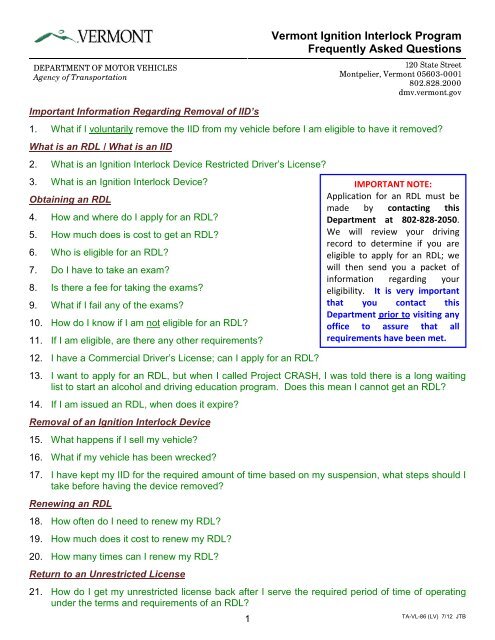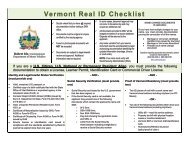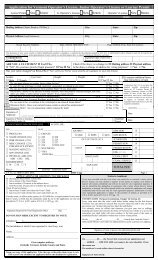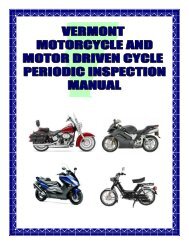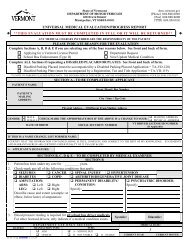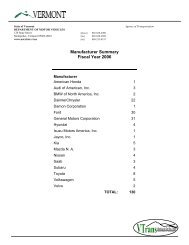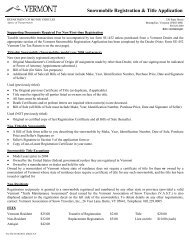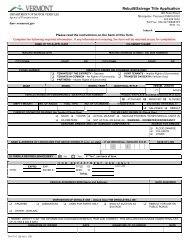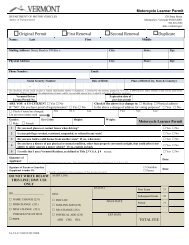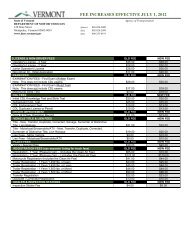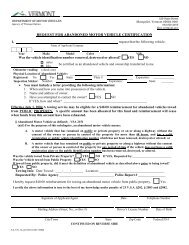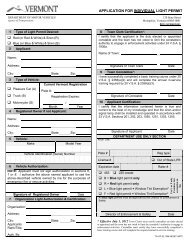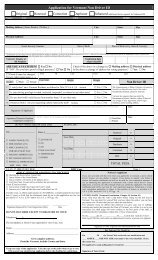Vermont Ignition Interlock Program Frequently Asked Questions
Vermont Ignition Interlock Program Frequently Asked Questions
Vermont Ignition Interlock Program Frequently Asked Questions
Create successful ePaper yourself
Turn your PDF publications into a flip-book with our unique Google optimized e-Paper software.
DEPARTMENT OF MOTOR VEHICLES<br />
Agency of Transportation<br />
Important Information Regarding Removal of IID’s<br />
1<br />
<strong>Vermont</strong> <strong>Ignition</strong> <strong>Interlock</strong> <strong>Program</strong><br />
<strong>Frequently</strong> <strong>Asked</strong> <strong>Questions</strong><br />
120 State Street<br />
Montpelier, <strong>Vermont</strong> 05603-0001<br />
802.828.2000<br />
dmv.vermont.gov<br />
1. What if I voluntarily remove the IID from my vehicle before I am eligible to have it removed?<br />
What is an RDL / What is an IID<br />
2. What is an <strong>Ignition</strong> <strong>Interlock</strong> Device Restricted Driver’s License?<br />
3. What is an <strong>Ignition</strong> <strong>Interlock</strong> Device?<br />
Obtaining an RDL<br />
4. How and where do I apply for an RDL?<br />
5. How much does is cost to get an RDL?<br />
6. Who is eligible for an RDL?<br />
7. Do I have to take an exam?<br />
8. Is there a fee for taking the exams?<br />
9. What if I fail any of the exams?<br />
10. How do I know if I am not eligible for an RDL?<br />
11. If I am eligible, are there any other requirements?<br />
12. I have a Commercial Driver’s License; can I apply for an RDL?<br />
13. I want to apply for an RDL, but when I called Project CRASH, I was told there is a long waiting<br />
list to start an alcohol and driving education program. Does this mean I cannot get an RDL?<br />
14. If I am issued an RDL, when does it expire?<br />
Removal of an <strong>Ignition</strong> <strong>Interlock</strong> Device<br />
15. What happens if I sell my vehicle?<br />
16. What if my vehicle has been wrecked?<br />
17. I have kept my IID for the required amount of time based on my suspension, what steps should I<br />
take before having the device removed?<br />
Renewing an RDL<br />
18. How often do I need to renew my RDL?<br />
19. How much does it cost to renew my RDL?<br />
20. How many times can I renew my RDL?<br />
Return to an Unrestricted License<br />
IMPORTANT NOTE:<br />
Application for an RDL must be<br />
made by contacting this<br />
Department at 802-828-2050.<br />
We will review your driving<br />
record to determine if you are<br />
eligible to apply for an RDL; we<br />
will then send you a packet of<br />
information regarding your<br />
eligibility. It is very important<br />
that you contact this<br />
Department prior to visiting any<br />
office to assure that all<br />
requirements have been met.<br />
21. How do I get my unrestricted license back after I serve the required period of time of operating<br />
under the terms and requirements of an RDL?<br />
TA-VL-86 (LV) 7/12 JTB
Obtaining and Installation of an <strong>Ignition</strong> <strong>Interlock</strong> Device<br />
22. Where can I get information about getting an IID installed?<br />
23. Are there different types of IID’s?<br />
24. Does it matter what type of IID I have installed?<br />
25. How much does it cost to have an IID?<br />
26. How do I use an IID?<br />
27. Do I need to have an IID installed on all vehicles owned/registered to me?<br />
28. Can I install an IID on my motorcycle?<br />
29. Can I install an IID on my snowmobile, motorboat or ATV?<br />
30. I need to rent a car; can I drive a rental car with my RDL?<br />
31. Do I need to notify you that I had the interlock installed?<br />
Operating a Vehicle Equipped with an <strong>Ignition</strong> <strong>Interlock</strong> Device<br />
32. What is “permanent lockout state”?<br />
33. What is a “random retest”?<br />
34. Will performing a "random retest" cause me to take my eyes off the road, creating a hazardous<br />
situation?<br />
35. What happens if I fail the breath test during a “random retest”?<br />
36. What happens if I do not provide a breath test during a “random retest”?<br />
37. Why do the lights flash and the horn blow if I fail a “random retest”, or if I do not provide a breath<br />
test during the “random retest”?<br />
38. If I fail a “random retest”, will my car turn off while I am driving?<br />
39. Can family members and friends drive my IID equipped vehicle?<br />
40. What if I am required to drive my employer’s company vehicle that has no IID?<br />
41. Can I drive a commercial vehicle with an RDL?<br />
Miscellaneous Information about <strong>Ignition</strong> <strong>Interlock</strong> Devices<br />
42. Does the IID need to be serviced or maintained in any way?<br />
43. What is a “swap out”?<br />
44. What kind of information does the IID record?<br />
45. Does the Department of Motor Vehicles monitor the IID?<br />
46. What if I forget to bring my car to the installer for servicing?<br />
47. What things will make me fail a breath test?<br />
48. What happens if I fail the breath test when I try to start my car?<br />
49. What happens if I fail a breath test, but I have not been drinking?<br />
50. Will the IID lose the memory data if the battery is disconnected?<br />
2
51. Can I use a remote car starter on my IID equipped vehicle?<br />
52. In extreme weather, can I go start my car and let it run with the heater or air conditioner on, until<br />
the car warms up or cools down?<br />
53. What happens if I have repair work or a <strong>Vermont</strong> State Inspection done on my IID equipped<br />
vehicle?<br />
54. What if I tried to use a balloon, canned air or other air source to mimic my breath sample?<br />
55. Can I have someone else take the breath test for me to start the vehicle?<br />
56. What if I did have someone else take the breath test for me so I could drive my car?<br />
57. If the IID unit malfunctions, will it shut the vehicle off?<br />
58. What happens if the vehicle stalls in traffic?<br />
59. Will installation of the IID damage the vehicle?<br />
60. What if I will temporarily be out-of-state; how will I meet the requirements of my RDL?<br />
61. I have been experiencing problems with my ignition interlock device, what do I do?<br />
62. I have been experiencing problems with my IID installer, how do I file a complaint against the<br />
installer?<br />
Violations FAQ’s<br />
63. What actions are considered violations of the terms and requirements of an RDL?<br />
Requests for Hearings FAQ’s<br />
64. I was denied an RDL, can I request a hearing?<br />
65. My RDL requirements were extended, can I request a hearing?<br />
66. Who do I contact to request a hearing?<br />
Introduction<br />
The <strong>Vermont</strong> Department of Motor Vehicles now issues <strong>Ignition</strong> <strong>Interlock</strong> Restricted Driver Licenses<br />
(RDL’s) to eligible alcohol-related DUI, and Refusal to Consent to a Breath Test, offenders. An RDL<br />
will allow offenders to operate non-commercial vehicles equipped with an ignition interlock device.<br />
The following FAQ’s will answer most of the questions you may have.<br />
Please read the FAQ’s carefully, and in their entirety, to determine if you are indeed<br />
eligible for an RDL; and to inform you what your requirements, responsibilities and<br />
commitments will be upon obtaining an RDL.<br />
Prior to being issued an RDL, you will be required to sign an <strong>Ignition</strong> <strong>Interlock</strong><br />
Participation Agreement,<br />
certifying that you fully understand you are entering into<br />
an agreement with the <strong>Vermont</strong> Department of Motor Vehicles, for which you agree<br />
you will abide by the <strong>Vermont</strong> <strong>Ignition</strong> <strong>Interlock</strong> Laws, and the <strong>Ignition</strong> <strong>Interlock</strong><br />
<strong>Program</strong> Rules.<br />
3
Important Information Regarding Removal of IID’s<br />
1. What if I voluntarily remove the IID from my vehicle before I am eligible to have it removed?<br />
The period of time for which you must have an IID in your vehicle are as follows:<br />
For DUI offenses:<br />
If this was your 1 st offense: 6 months If this was your 2 nd offense: 18 months<br />
If this was your 3 rd or subsequent offense: 3 years<br />
For applicants under 21:<br />
If this was your 1 st offense: 9 months<br />
If this was your 2 nd or subsequent offense: 18 months<br />
For Refusal of Test offenses:<br />
If this was your 1 st offense: 9 months If this was your 2 nd offense: 2 years<br />
If this was your 3 rd or subsequent offense: 4 years<br />
For applicants under 21:<br />
If this was your 1 st offense: 1 year<br />
If this was your 2 nd or subsequent offense: 2 years, or age of 21, whichever is greater<br />
Total Abstinence Applicants:<br />
If you apply for reinstatement through the Total Abstinence program, you will be required to<br />
either:<br />
1. Operate under the terms and requirements of an RDL during your 3 years of<br />
abstinence, or<br />
2. Operate under the terms and requirements of an RDL for 1 year after having proved 3<br />
years of abstinence.<br />
If you regained your Driver’s License under the Total Abstinence program, but were<br />
subsequently found to have consumed any amount of alcohol, you will be required to<br />
have an IID in your vehicle permanently.<br />
PLEASE NOTE: If you remove the IID from your vehicle before you are eligible, after we<br />
receive notification from the IID installer/manufacturer, you will be suspended for the remaining<br />
term of your original suspension. A new suspension with a 10-day lead time will be mailed to<br />
you. The lead time and any Departmental processing time will not be counted towards your<br />
suspension.<br />
What is an RDL / What is an IID<br />
2. What is an <strong>Ignition</strong> <strong>Interlock</strong> Device Restricted Driver’s License?<br />
An <strong>Ignition</strong> <strong>Interlock</strong> Device Restricted License, referred to as an “RDL”, allows you to drive noncommercial<br />
vehicles equipped with an ignition interlock device, while your regular license is<br />
suspended or revoked for an alcohol-related driving under the influence offense. You are granted<br />
a conditional reinstatement ahead of your normal eligibility date if you participate in the <strong>Ignition</strong><br />
<strong>Interlock</strong> <strong>Program</strong>. If granted an RDL, you must adhere to all of the terms and requirements<br />
associated with an RDL; failing to do so will result in an extension of your IID requirements. See<br />
Violations.<br />
4
3. What is an <strong>Ignition</strong> <strong>Interlock</strong> Device?<br />
An <strong>Ignition</strong> <strong>Interlock</strong> Device, referred to as an “IID”, is an after-market device, slightly larger than a<br />
cell phone, which is installed in a vehicle. The IID is connected to the starter or ignition, or other<br />
on-board computer system of a vehicle. The device prevents a driver from operating the vehicle if<br />
the driver has been drinking. Before starting the vehicle, a driver must blow into the device; if the<br />
driver’s BAC is at or over a pre-set limit, 0.02 in <strong>Vermont</strong>, the IID will not allow the vehicle to start.<br />
Once the vehicle is started, at random times during the operation of the vehicle, the device will<br />
prompt the driver to provide another breath sample, referred to as “random retests”. If the breath<br />
sample is not provided, or if the breath sample is at or exceeds a BAC of 0.02, the IID will log the<br />
event as a “failure”, and will then signal the vehicle to begin flashing the lights and sounding the<br />
horn. This will continue until the vehicle is turned off, or a clean breath sample has been provided.<br />
4. How and where do I apply for an RDL?<br />
Obtaining an RDL<br />
Application for an RDL must be made by contacting the Department, by phone, at 802-828-2050.<br />
We will review your driving record to determine if you are eligible to apply for an RDL. We will<br />
then send you a packet of information regarding your eligibility; this can include a list of<br />
reinstatement/eligibility requirements, an RDL Application, list of IID manufacturers, etc. It is very<br />
important that you contact this Department prior to visiting any office to assure that all<br />
requirements have been met.<br />
5. How much does it cost to get an RDL?<br />
The cost for a new RDL is $125.00. If you have an Enhanced Driver’s License (EDL), the cost is<br />
$150.00.<br />
6. Who is eligible for an RDL?<br />
You must have served a portion of your suspension term as follows:<br />
If this was your 1 st offense, you must have served 30 days of your suspension.<br />
If this was your 2 nd offense, you must have served 90 days of your suspension.<br />
If this was your 3 rd or subsequent offense, you must have served 1 year of your suspension.<br />
For applicants under 21:<br />
If this was your 1 st offense, you must have served 30 days of your suspension.<br />
If this was your 2 nd or subsequent offense, you must have served 90 days of your<br />
suspension.<br />
7. Do I have to take an exam?<br />
If your license was revoked, or if your license has been expired 3 or more years, you will be<br />
required to take the eye, written and driving exams prior to obtaining an RDL. You can contact<br />
our Information Unit at (802) 828-2050 for further information.<br />
Note: The vehicle being used for the driving exam must be equipped with a cameraequipped<br />
IID; if your BAC was .16 or above, the IID must also have GPS capabilities. See<br />
Obtaining and Installation of an <strong>Ignition</strong> <strong>Interlock</strong> Device.<br />
5
8. Is there a fee for taking the exams?<br />
Yes, all exam fees are applicable. The fees are as follows:<br />
Written Exam: $30.00 Driving Exam: $18.00 Eye Exam: No fee<br />
Note: You will be required to the pay the $125.00 RDL fee at the time you take the<br />
exams. When you appear for the exams, you will need a total of $173.00 to obtain an<br />
RDL. If you have an Enhanced Driver’s License (EDL), you will need an additional<br />
$25.00, for a total of $198.00.<br />
9. What happens if I fail any of the exams?<br />
Eye Exam: If the screening determines that your vision does not meet the required standards<br />
of 20/40, you will be referred to an eye doctor of your choice at your expense. The eye doctor<br />
will complete an evaluation to determine if any restrictions should be placed on your driving<br />
privilege.<br />
Written/Computer Exam: The written/computer exam has 20 questions. You must answer at<br />
least 16 questions correctly to pass the test. If you fail the exam, you must wait at least one<br />
day before taking another one.<br />
Driving Exam: The driving exam will not be given until you have passed the eye and<br />
written/computer exams. If you fail the driving exam, an RDL may be issued; however, you will<br />
be restricted to operating a vehicle only when accompanied by a licensed individual over the<br />
age of 25 years old.<br />
Note: You will be required to pay the $125.00 RDL fee even if you fail the driving<br />
exam.<br />
10. How do I know if I am not eligible for an RDL?<br />
You are not eligible for an RDL for any of the following reasons:<br />
The driving under the influence offense for which you are suspended involved a crash resulting<br />
in serious injury or death.<br />
You are currently under suspension for driving while under the influence of drugs.<br />
You currently hold a Learner’s Permit.<br />
You currently hold a Junior Operator’s License<br />
You are under suspension for a reason other than a driving under the influence conviction.<br />
11. If I am eligible, are there any other requirements?<br />
Yes. You must also do the following:<br />
Pay the Reinstatement Fee.<br />
Provide proof of Financial Responsibility (SR-22 Certificate).<br />
Provide proof of enrollment in an alcohol and driving education program, approved by Project<br />
CRASH. An authorized Project CRASH agent will need to complete a Project CRASH<br />
Certification of Enrollment in an Alcohol and Driving Education <strong>Program</strong>, TA-VL-81.<br />
Provide proof of installation of an approved IID. When you have the IID installed, have the<br />
installer complete a Certification of <strong>Ignition</strong> <strong>Interlock</strong> Device Installation, TA-VL-82.<br />
6
12. I have a Commercial Driver’s License; can I apply for an RDL?<br />
Yes. However, your CDL will be downgraded to a Class D license which does not permit<br />
operation of commercial vehicles.<br />
13. I want to apply for an RDL, but when I called Project CRASH, I was told there is a long<br />
waiting list to start an alcohol and driving education program. Does this mean I cannot get<br />
an RDL?<br />
No. You can apply for an RDL. You only need to be enrolled in a program. As proof of<br />
enrollment, an authorized Project CRASH agent will need to complete a Project CRASH<br />
Certification of Enrollment in an Alcohol and Driving Education <strong>Program</strong>, TA-VL-81.<br />
14. If I am issued an RDL, when does it expire?<br />
Your initial RDL will expire on your second birthday after the issuance of your initial RDL.<br />
Example: If your date of birth is 2/15/80, and you are issued an RDL on 8/15/12, your initial<br />
RDL will expire on 2/15/14. You will then need to renew your RDL on a yearly basis thereafter.<br />
Removal of an <strong>Ignition</strong> <strong>Interlock</strong> Device<br />
15. What happens if I sell my vehicle?<br />
Prior to selling the vehicle you must have the IID removed by the installer and then installed in<br />
your new vehicle. You will also need to have the installer complete a Certification of <strong>Ignition</strong><br />
<strong>Interlock</strong> Device Installation, TA-VL-82, and return it to this Department.<br />
16. What if my vehicle has been wrecked?<br />
Contact your installer for specific instructions on how to handle this situation. Depending upon the<br />
amount of damage to your vehicle, you may need to obtain a new IID. Should you have to replace<br />
your vehicle, you will need to have a device installed in your new vehicle. Have the installer<br />
complete a Certification of <strong>Ignition</strong> <strong>Interlock</strong> Device Installation, TA-VL-82, and return it to this<br />
Department.<br />
17. I have kept my IID for the required amount of time based on my suspension, what steps<br />
should I take before having the device removed?<br />
Contact DMV at 802-828-2050 to verify that you are eligible to have the interlock removed. If you<br />
have met your original reinstatement requirements, DMV will advise you that you may have the IID<br />
removed from your vehicle. You will also need to re-apply for the restoration of your unrestricted<br />
license by completing a Duplicate or Corrected Registration / License / Learner Permit or Removal<br />
of Restriction Application, TA-VL-15. See Return to an Unrestricted License.<br />
18. How often do I need to renew my RDL?<br />
Renewing an RDL<br />
Your RDL must be renewed on a yearly basis. A renewal notice, along with an Application for<br />
<strong>Ignition</strong> <strong>Interlock</strong> Device Restricted Driver’s License will be mailed to you 30 days before your RDL<br />
expires. You will need to complete the application and return it to DMV with the appropriate<br />
renewal fee. If you do not renew your RDL on or by the expiration, you will be issued a<br />
7
suspension for failing to renew your RDL, and will remain under suspension until you renew your<br />
RDL and pay the Reinstatement Fee.<br />
Note: The expiration date of your initial RDL will expire on your second birthday after the<br />
issuance of your initial RDL. You will then need to renew your RDL on a yearly basis<br />
thereafter.<br />
19. How much does it cost to renew my RDL?<br />
The cost for an RDL renewal is $125.00 per year. If you have an Enhanced Driver’s License<br />
(EDL), the cost is $150.00 per year.<br />
20. How many times can I renew my RDL?<br />
Provided you are willing to pay all of the associated costs of having an interlock device (i.e. IID<br />
installation, purchasing or leasing, calibrating and data retrieval, etc.; as well as the yearly RDL<br />
renewal fee) your RDL can be renewed on a yearly basis for an indefinite number of years.<br />
Return to an Unrestricted License<br />
21. How do I get my unrestricted license back after I serve the required period of time of<br />
operating under the terms and requirements of an RDL?<br />
When you have met the original reinstatement requirements (completion of CRASH, etc.) at the<br />
end of the required period of time for operating under an RDL, you may apply for the restoration of<br />
your unrestricted license. You will need to complete a Duplicate or Corrected Registration /<br />
License / Learner Permit or Removal of Restriction Application, TA-VL-15. However, please note<br />
the following two (2) exceptions:<br />
1. If you committed any violations which would result in an extension of your RDL requirements,<br />
you will not be eligible for the restoration of your unrestricted license as described below;<br />
instead, you will need to serve the extended period of time. See Violations.<br />
2. If you have previously been reinstated for Total Abstinence, you are not eligible for an<br />
unrestricted license; you will be required to have an IID in your vehicle permanently.<br />
The terms and requirements for restoration are as follows:<br />
For Driving Under the Influence offenses:<br />
If this was your 1 st offense: Operate under the terms and requirements of an RDL for 6<br />
months, as well as completion of CRASH, etc.<br />
If this was your 2 nd offense: Operate under the terms and requirements of an RDL for 18<br />
months, as well as completion of CRASH, etc.<br />
If this was your 3 rd or subsequent offense: Operate under the terms and requirements of an<br />
RDL for 3 years, plus prove Total Abstinence (see below).<br />
For applicants under 21:<br />
If this was your 1 st offense: Operate under the terms and requirements of an RDL<br />
for 9 months, as well as completion of CRASH, etc.<br />
If this was your 2 nd or subsequent offense: Operate under the terms and<br />
requirements of an RDL for 18 months or until reaching the age of 21, whichever is<br />
longer; as well as completion of CRASH, etc.<br />
8
For Refusal to Consent to Breath Test offenses:<br />
If this was your 1 st offense: Operate under the terms and requirements of an RDL for 9<br />
months, as well as completion of CRASH, etc.<br />
If this was your 2 nd offense: Operate under the terms and requirements of an RDL for 2<br />
years, as well as completion of CRASH, etc.<br />
If this was your 3 rd or subsequent offense: Operate under the terms and requirements of<br />
an RDL for 4 years, plus prove Total Abstinence (see below).<br />
For applicants under the age of 21:<br />
If this was your 1 st offense: Operate under the terms and requirements of an RDL<br />
for 1 year, as well as completion of CRASH, etc.<br />
If this was your 2 nd or subsequent offense: Operate under the terms and<br />
requirements of an RDL for 2 years, or until reaching the age of 21, whichever<br />
period is longer; as well as completion of CRASH, etc.<br />
For Total Abstinence applicants:<br />
If you apply for reinstatement through the Total Abstinence program, you will be required to<br />
either:<br />
1. Operate under the terms and requirements of an RDL during your three (3) years of<br />
abstinence, or<br />
2. Operate under the terms and requirements of an RDL for one (1) year after having<br />
proved three (3) years of abstinence.<br />
If you regained your Driver’s License under the Total Abstinence program, but then<br />
reoffended (convicted of another DUI or Refusal of Test offense), you will be required to<br />
have an IID in your vehicle permanently.<br />
Please Note: If your alcohol-related suspensions include both a DUI offense and a Refusal to<br />
Consent to a Breath test offense, you must operate under the terms and requirements of an<br />
RDL for whichever period is longer. For example: If you have a first offense DUI, the period<br />
of time for operating under the terms and requirements of an RDL is 6 months. If you also<br />
have a first offense Refusal of Test, the period of time for operating under the terms and<br />
requirements of an RDL is 9 months. In a case such as this, you would be required to operate<br />
under the terms and requirements of an RDL for 9 months; which is the longer period of time.<br />
Obtaining and Installation of an <strong>Ignition</strong> <strong>Interlock</strong> Device<br />
22. Where can I get information about getting an IID installed?<br />
You can go to our website (dmv.vermont.gov) to find a list of manufacturers who are certified to<br />
provide ignition interlock device services in <strong>Vermont</strong>. If you do not have internet access, you can<br />
contact our Information Unit at (802) 828-2050.<br />
23. Are there different types of IID’s?<br />
Yes. For the most part, there are two types of IID’s; (1) a “standard” device and, (2) a device that<br />
is equipped with a camera. Some of the camera-equipped devices also have Global Positioning<br />
System (GPS) and “real-time” reporting capabilities.<br />
9
24. Does it matter what type of IID I have installed?<br />
Yes. You must install an IID that is equipped with a camera.<br />
However, if your BAC was .16 or above, you will be required to install a camera-equipped IID<br />
with GPS capabilities, and have it in your vehicle for the entire period of time you must operate<br />
under the terms and requirements of an RDL.<br />
And in some cases, the courts and/or Department of Corrections may require you to install a<br />
device that has “Real-Time” reporting” and/or GPS capabilities.<br />
The list of manufacturers located on our website (dmv.vermont.gov) will indicate the types of IID’s<br />
they offer. If you do not have internet access, you can contact our Information Unit at (802) 828-<br />
2050.<br />
25. How much does it cost to have an IID?<br />
Costs will vary by manufacturer, installer and type of device. You are responsible for all the costs<br />
associated with an ignition interlock device. These costs can include: installation, purchasing or<br />
leasing, removal, calibrating, data retrieval, servicing and any other fees charged by the<br />
installer/manufacturer. Contact the manufacturers to find one that best suits your needs.<br />
26. How do I use an IID?<br />
When the device is installed on your vehicle, the installer will provide you with both written, and<br />
hands on training, on how to operate a vehicle equipped with an IID.<br />
27. Do I need to have an IID installed on all vehicles owned/registered to me?<br />
No. However, you cannot drive a vehicle without an IID. If you have multiple vehicles, you can<br />
install an IID on the only vehicle you will use, or you can install IID’s on multiple vehicles. If you<br />
install IID’s on more than one vehicle, you will have to pay all of the associated fees (i.e.<br />
installation, purchasing or leasing, removal, calibrating, data retrieval, servicing, etc.) for each IID<br />
installed in each vehicle you will be driving. The vehicle(s) in which the device is installed must be<br />
registered, inspected and insured.<br />
28. Can I install an IID on my motorcycle?<br />
No. Because IID’s perform “random retests”, for safety purposes, IID’s cannot be installed on<br />
motorcycles.<br />
29. Can I install an IID on my snowmobile, motorboat or ATV?<br />
No. IID’s can only be installed on vehicles (cars and non-commercial trucks).<br />
30. I need to rent a car; can I drive a rental car with my RDL?<br />
The terms and requirements of your RDL allow you to drive only vehicles equipped with an IID; if<br />
the rental car does not have an IID, you cannot drive the rental vehicle.<br />
31. Do I need to notify you that I had the interlock installed?<br />
Yes. When you have the IID installed, have the installer complete a Certification of <strong>Ignition</strong><br />
<strong>Interlock</strong> Device Installation, TA-VL-82.<br />
10
Operating a Vehicle Equipped with an <strong>Ignition</strong> <strong>Interlock</strong> Device<br />
32. What is “permanent lockout state”?<br />
When certain violations are logged by the IID, when the vehicle is turned off, the IID will not allow<br />
the vehicle to start again under any circumstances. The vehicle would need to be towed to the<br />
installer for servicing before you can operate it again. The violations which result in a permanent<br />
lockout state are:<br />
If the IID detects tampering, circumvention or bypass attempts.<br />
A total of 3 refusals to provide a retest sample during the period of time you hold an RDL.<br />
A scheduled service date is missed.<br />
Service is not obtained within 5 days of the service reminder.<br />
Some of the above violations will also result in an extension of your RDL requirements. See<br />
Violations.<br />
33. What is a “random retest”?<br />
To prevent a driver from having someone else blow into the IID to start a vehicle, and to prevent a<br />
driver from drinking while driving, the IID requires the driver to submit to random retests at variable<br />
intervals after a driver has passed an initial breath test and started the vehicle. The IID will signal<br />
you to take a retest within a certain amount of time after starting your vehicle.<br />
34. Will performing a "random retest" cause me to take my eyes off the road, creating a<br />
hazardous situation?<br />
No. When the IID signals for a retest, the driver has a few minutes to provide the sample or to pull<br />
over to the side of the road in a safe area to provide the breath sample. There are no buttons to<br />
push; the driver must only breathe into the unit to complete a breath sample. This is much simpler<br />
than using a cell phone or tuning a car stereo.<br />
35. What happens if I fail the breath test during a “random retest”?<br />
If the IID detects a BAC of 0.02 or greater, the horn will sound repeatedly and the headlights will<br />
flash until the vehicle is turned off. Once the vehicle is turned off, the IID will not allow you to<br />
restart the vehicle within 3 minutes without taking an initial breath test. Failing a “random retest”<br />
will result in an extension of your RDL requirements. See Violations.<br />
36. What happens if I do not provide a breath test during a “random retest”?<br />
If you fail to do the retest within 10 minutes, the horn will sound repeatedly and the headlights will<br />
flash until the vehicle is turned off. Once the vehicle is turned off, the IID will not allow you to<br />
restart the vehicle within 3 minutes without taking an initial breath test. Upon a total of 3 refusals<br />
to provide a retest during the period of time you hold an RDL, the IID will place your vehicle in a<br />
permanent lockout state; the vehicle would have to be towed to the installer for service before you<br />
can operate it again.<br />
37. Why do the lights flash and the horn blow if I fail a “random retest”, or if I do not provide a<br />
breath test during the “random retest”?<br />
If you have failed the “random retest” breath test, or if you do not provide a breath sample for a<br />
“random retest”, the flashing of lights and sounding of the horn is a mechanism of alerting law<br />
11
enforcement who are in the area you are travelling. It is a warning that they should conduct a<br />
traffic stop on your vehicle.<br />
38. If I fail a “random retest”, will my car turn off while I am driving?<br />
No. For safety reasons, the device cannot turn off the vehicle while you are driving. If you turn<br />
the vehicle off, it will not start again, but it will not turn off while you are driving.<br />
39. Can family members and friends drive my IID equipped vehicle?<br />
Yes. However, because they will need to blow into the device to start the vehicle, you need to be<br />
aware that you are responsible for the readings recorded by the ignition interlock device. If<br />
someone else blows into the device, and that person has a BAC of 0.02 or greater, it will be<br />
presumed that you were the person who provided the breath sample, and that you were over the<br />
limit (considered a “failure”). This “failure” will appear on the report that is distributed to the<br />
Department of Motor Vehicles and the Department of Corrections.<br />
40. What if I am required to drive my employer’s company vehicle that has no IID?<br />
You may only operate vehicles equipped with an IID.<br />
41. Can I drive a commercial vehicle with an RDL?<br />
No.<br />
Miscellaneous Information about <strong>Ignition</strong> <strong>Interlock</strong> Devices<br />
42. Does the IID need to be serviced or maintained in any way?<br />
Yes. Once installed in your vehicle, the IID must be calibrated and inspected by a certified<br />
installer, or “swapped out” (if applicable), every 30 days for the duration of the terms and<br />
requirements of an RDL. The inspection is done to make sure the IID is working properly and to<br />
detect any issues of non-compliance. At the time of inspection, the installer will:<br />
Review the data recorded in the device’s memory.<br />
Inspect the device for indications of tampering.<br />
Calibrate the device.<br />
Forward data reports to both DMV and the Department of Corrections.<br />
43. What is a “swap out”?<br />
Some manufacturers perform “swap outs” instead of requiring you to go to an installer every 30<br />
days. The manufacturer will send you a new unit every 30 days, at which time you will remove the<br />
current device, and replace it with the new device. When the manufacturer receives the device<br />
you removed, they will:<br />
Review the data recorded in the device’s memory.<br />
Inspect the device for indications of tampering.<br />
Forward data reports to both DMV and the Department of Corrections.<br />
12
44. What kind of information does the IID record?<br />
The IID collects and stores the information below, which is reported to the Department of Motor<br />
Vehicles and the Department of Corrections. This information is also provided to Project CRASH.<br />
The date and time of any use, or attempted use of a vehicle.<br />
The date and time of any attempt to tamper, circumvent or bypass the device.<br />
The date, time and alcohol concentration, in grams per 210 liters, of each breath sample<br />
provided to the device.<br />
The date and time of any malfunctions of the device.<br />
The date and time of any failures to provide retest samples.<br />
The date and time a “service required” message is issued to the customer by the device.<br />
The date any service is performed.<br />
The mileage and hours of operation of the vehicle since the previous service was performed.<br />
45. Does the Department of Motor Vehicles monitor the IID?<br />
Yes. When the IID is serviced every 30 days, the installer forwards the data reports to both DMV<br />
and the Department of Corrections. If the data report indicates a failure to comply with any of the<br />
interlock program requirements, it will result in an extension of your RDL requirements. See<br />
Violations.<br />
46. What if I forget to bring my car to the installer for servicing?<br />
The device will give you a reminder 7 days prior to a scheduled service date, followed by a<br />
warning to obtain service within 5 days. If you fail to bring your vehicle to the installer for service<br />
within those 5 days, the IID will place your vehicle in a permanent lockout state; the vehicle would<br />
have to be towed to the installer for service before you can operate it again. Failure to bring your<br />
car in for service will result in an extension of your RDL requirements. See Violations.<br />
47. What things will make me fail a breath test?<br />
Anything containing alcohol; alcoholic beverages, mouthwash, food cooked with alcohol, some<br />
fermented fruits, some toothpastes, cough medicine, inhalers, etc. If your blood alcohol<br />
concentration is at, or over, 0.02 as a result of consuming any of these items, you will not be<br />
allowed to start the vehicle. The IID will record the failure, which will be noted in the data report.<br />
48. What happens if I fail the breath test when I try to start my car?<br />
The vehicle will not start and the IID will enter a short lockout period of a few minutes. This<br />
lockout period allows an opportunity for the alcohol to dissipate from the mouth and for you to<br />
consider the reason for the failed breath alcohol test, for example; is the failure a result of the use<br />
of mouthwash, cough syrup, etc., or as a result of consuming too much alcohol. The IID will<br />
record the failure, which will be noted in the data report. If you make 3 attempts to start a vehicle<br />
with a BAC of .04 or above, your IID requirements will be extended for a period of 3 months. See<br />
Violations.<br />
49. What happens if I fail a breath test, but I have not been drinking?<br />
Rinse your mouth with water and keep taking a retest until you successfully pass the test.<br />
13
50. Will the IID lose the memory data if the battery is disconnected?<br />
No. The device has a battery backup system to protect the data memory.<br />
51. Can I use a remote car starter on my IID equipped vehicle?<br />
No. Because you have to blow into the device to start your car, a remote car starter will not work.<br />
52. In extreme weather, can I go start my car and let it run with the heater or air conditioner on,<br />
until the car warms up or cools down?<br />
No. The IID will randomly ask for breath tests (“random retests”) while the vehicle is running. If<br />
you fail to do the retest within 10 minutes, the horn will sound repeatedly and the headlights will<br />
flash until the vehicle is turned off. The IID will log this as failure to provide a “random retest”<br />
which may lead to a permanent lockout state. See Violations.<br />
53. What happens if I have repair work or a <strong>Vermont</strong> State Inspection done on my IID equipped<br />
vehicle?<br />
We strongly suggest that you notify your installer before performing vehicle maintenance, service<br />
or repairs that would involve starting or driving your vehicle or disconnecting the battery. Your<br />
auto repair technician can contact your installer for specific instructions on how to avoid recording<br />
erroneous violations.<br />
54. What if I tried to use a balloon, canned air or other air source to mimic my breath sample?<br />
All IID’s have anti-circumvention techniques, which cause the IID to abort phony breath samples.<br />
The IID will detect and log this as an attempt to bypass, tamper with or circumvent the device and<br />
will place the vehicle in a permanent lockout state. The vehicle would have to be towed to the<br />
installer for service before you can operate it again.<br />
55. Can I have someone else take the breath test for me to start the vehicle?<br />
No. <strong>Vermont</strong> law and <strong>Ignition</strong> <strong>Interlock</strong> <strong>Program</strong> Rules make it unlawful for an RDL holder to<br />
request or solicit another person to blow into, or otherwise activate the device, for the purpose of<br />
operating the IID equipped vehicle while you are under the influence of alcohol. A violation such<br />
as this will result in an extension of your RDL requirements. See Violations.<br />
56. What if I did have someone else take the breath test for me so I could drive my car?<br />
If the car was started illegally, because the IID randomly prompts you for a "random retest", a<br />
couple of things can happen:<br />
When you are prompted to take the retest, if you fail to do so within 10 minutes, the horn will<br />
sound repeatedly and the headlights will flash until the vehicle is turned off. Once the vehicle<br />
is turned off, the IID will not allow you to restart the vehicle within 3 minutes without taking an<br />
initial breath test.<br />
Upon a total of 3 refusals to provide a retest during the period of time you hold an RDL, the<br />
IID will place your vehicle in a permanent lockout state; the vehicle would have to be towed<br />
to the installer for service before you can operate it again. This will also result in an<br />
extension of your RDL requirements. See Violations.<br />
If you take the retest and the IID detects a BAC of 0.02 or greater, the horn will sound<br />
repeatedly and the headlights will flash until the vehicle is turned off. Once the vehicle is<br />
turned off, the IID will not allow you to restart the vehicle within 3 minutes without taking an<br />
14
initial breath test. Failing a “random retest” because of a BAC of .04 or above will result in an<br />
extension of your RDL requirements. See Violations.<br />
57. If the IID unit malfunctions, will it shut the vehicle off?<br />
No. The IID unit has no means of interrupting the operation of a vehicle once it is started.<br />
58. What happens if the vehicle stalls in traffic?<br />
The IID unit permits you to restart the vehicle without having to provide another breath sample, but<br />
a breath sample will be requested shortly after restarting.<br />
59. Will installation of the IID damage the vehicle?<br />
No. The IID unit is only connected to the wiring under the dash and under the hood. At the end of<br />
the program, the installer should restore the wiring to their pre-IID installation conditions.<br />
60. What if I will temporarily be out-of-state; how will I meet the requirements of my RDL?<br />
<strong>Vermont</strong> requirements still need to be maintained. Contact the manufacturer of your IID to locate<br />
an authorized interlock installer in the jurisdiction you will be in, who will provide you with the<br />
required services. It is your responsibility to work with your interlock manufacturer and authorized<br />
installer to provide us with all required reporting until you return to <strong>Vermont</strong>.<br />
61. I have been experiencing problems with my ignition interlock device, what do I do?<br />
Contact your installer. If it is after their normal business hours, your installer should have provided<br />
you with a 24 hour emergency telephone number for assistance.<br />
62. I have been experiencing problems with my IID installer, how do I file a complaint against<br />
the installer?<br />
Contact the manufacturer of the IID installed in your vehicle. A list of manufacturers can be found<br />
on our website (dmv.vermont.gov), or may be found in the information, pamphlet or manual you<br />
received when the IID was installed in your vehicle.<br />
Violations<br />
63. What actions are considered violations of the terms and requirements of an RDL?<br />
The following actions are considered violations of the terms and requirements of an RDL and will<br />
result in an extension of the period of time you must operate under the terms and requirements of<br />
an RDL:<br />
1. If you make three (3) attempts to start a vehicle with a BAC of .04 or above, your IID<br />
requirements will be extended for a period of three (3) months.<br />
Any subsequent 3 attempts to start a vehicle with a BAC of .04 or above, will result in<br />
additional three (3) month extensions which will run consecutively (following one after the<br />
other).<br />
Example: If your IID requirements were to end on January 1, 2013; but you<br />
made 3 attempts to start a vehicle with a BAC of .04 or above, your IID<br />
requirements would have been extended until April 1, 2013. If you make another<br />
3 attempts to start a vehicle with a BAC of .04 or above, your IID requirements<br />
will be extended another 3 months; until July 1, 2013.<br />
15
2. If you fail one (1) random retest due to a BAC of .04 or above, but less than .08, your IID<br />
requirements will be extended for a period of three (3) months.<br />
Any subsequent random retest failures due to a BAC of .04 or above, but less than .08,<br />
will result in additional three (3) month extensions which will run consecutively (following<br />
one after the other).<br />
Example: If your IID requirements were to end on January 1, 2013; but you<br />
failed a random retest due to a BAC of .04 or above, but less than .08, your IID<br />
requirements would have been extended until April 1, 2013. If you fail another<br />
random retest due to a BAC of .04 or above, but less than .08, your IID<br />
requirements will be extended another 3 months; until July 1, 2013.<br />
3. If you fail one (1) random retest due to a BAC of .08 or above, your IID requirements will be<br />
extended for a period of six (6) months.<br />
Any subsequent random retest failures due to a BAC of .08 or above will result in<br />
additional six (6) month extensions which will run consecutively (following one after the<br />
other).<br />
Example: If your IID requirements were to end on January 1, 2013; but you<br />
failed a random retest due to a BAC of .08 or above, your IID requirements would<br />
have been extended until July 1, 2013. If you fail another random retest due to a<br />
BAC of .08 or above, your IID requirements will be extended another 6 months;<br />
until January 1, 2014.<br />
4. If you (a) operate a motor vehicle not equipped with an IID, or (b) attempt to tamper with or<br />
circumvent the device, or (c) failure to pullover after failing a random retest your IID<br />
requirements will be extended for a period of six (6) months.<br />
5. If you miss a required service visit to have the IID calibrated, your IID requirements will be<br />
extended for a period of sixty (60) days.<br />
Requests for Hearings<br />
64. I was denied an RDL, can I request a hearing?<br />
A person whose application for an RDL is denied may request a hearing. The hearing is to<br />
provide the person with the opportunity to show cause why the decision of the Commissioner<br />
should not be upheld.<br />
65. My RDL requirements were extended, can I request a hearing?<br />
A person who commits any violations which would result in an extension of his or her RDL<br />
requirements, may request an administrative hearing for the sole purpose of verifying the record of<br />
adjudication or conviction.<br />
66. Who do I contact to request a hearing?<br />
Agency of Transportation<br />
Policy & Hearings Section<br />
One National Life Drive<br />
Montpelier, VT 05633-5001<br />
(802) 828-2016<br />
16


